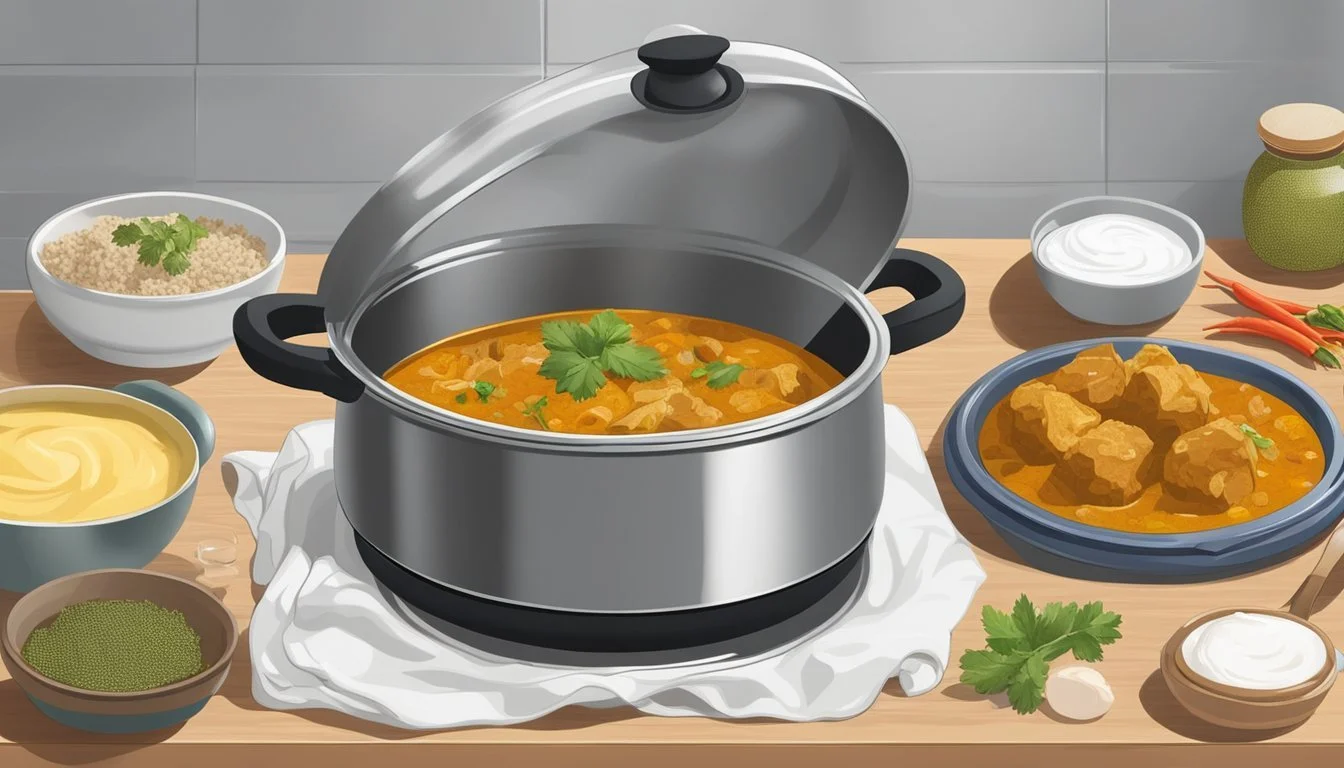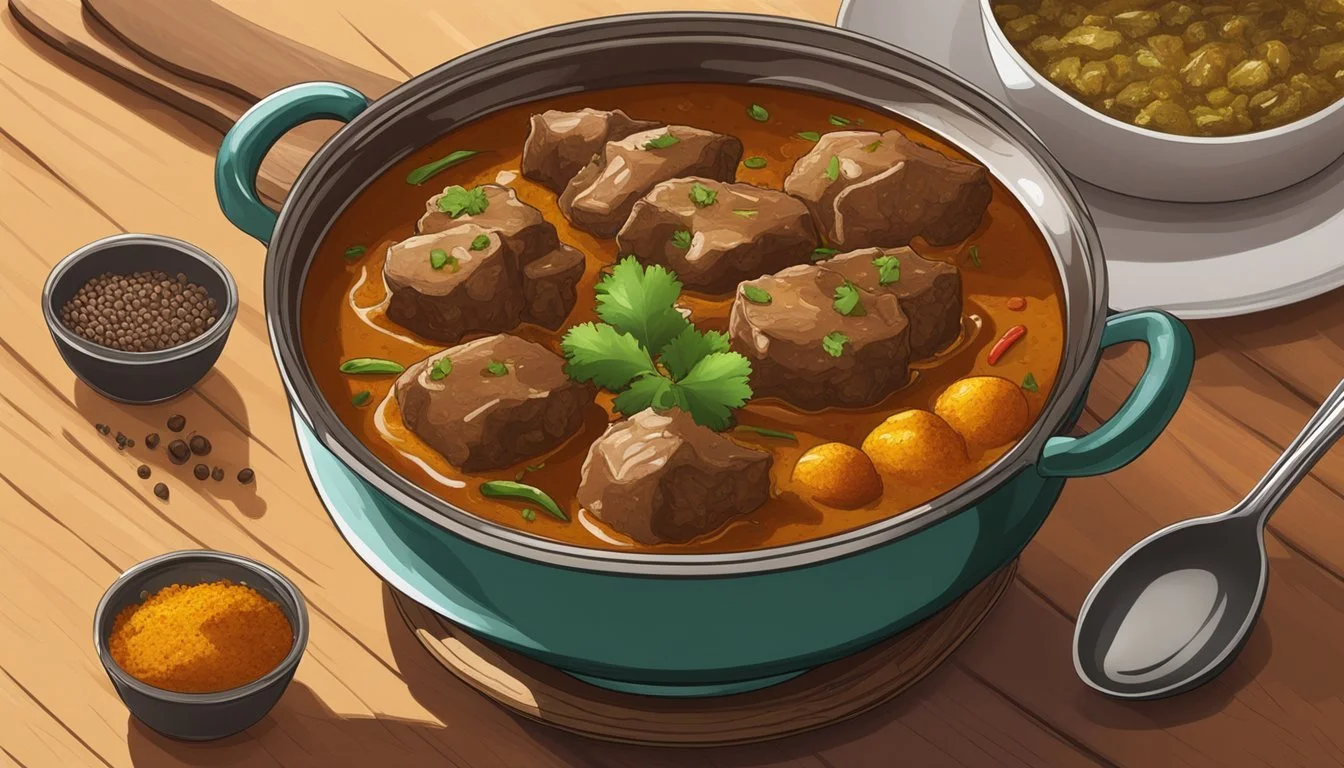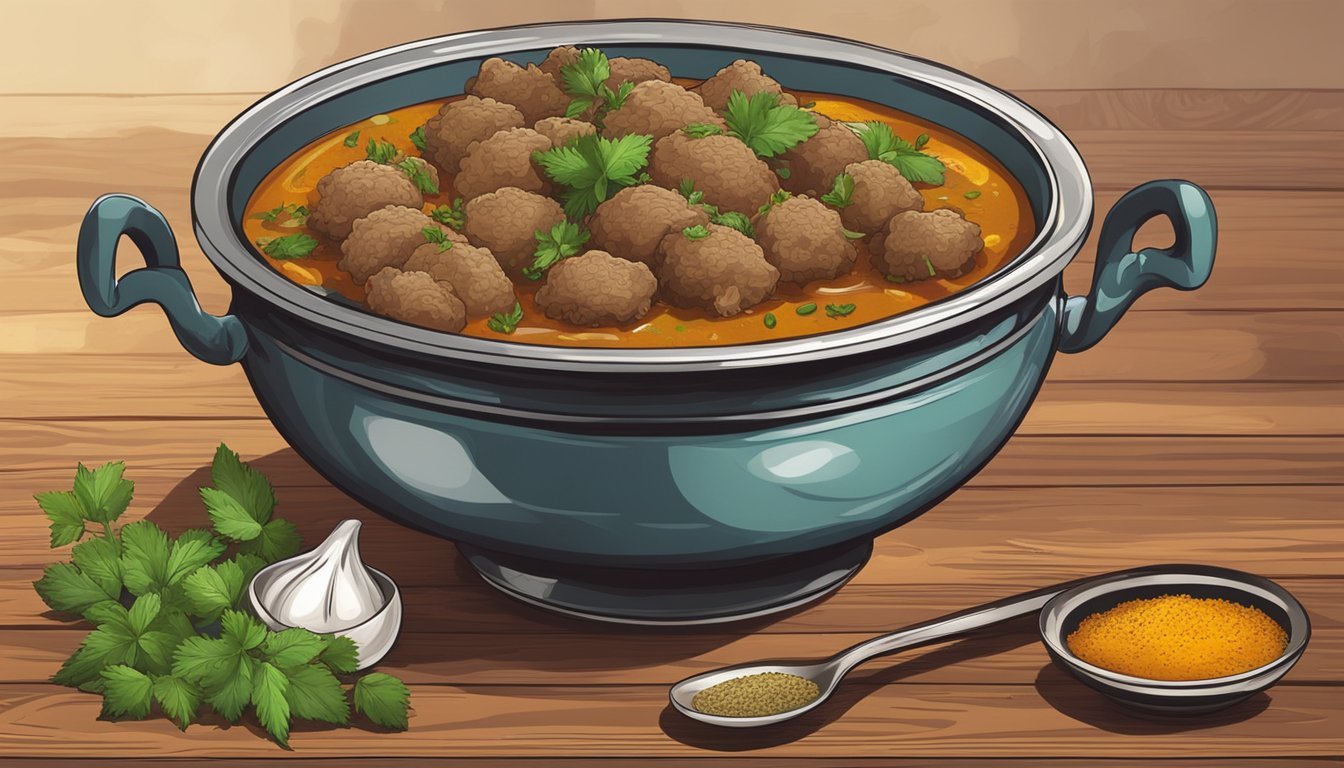Best Way to Reheat Lamb Curry Without Losing Flavor or Texture
Reheating lamb curry properly is essential to enjoying the leftovers as much as the original meal. Lamb curry, known for its tender meat and rich, flavorful sauce, can easily become dry or lose its texture if not heated correctly. Ensuring the juicy tenderness of the lamb and the robustness of the aromatic sauce remains intact calls for a methodical approach. By adhering to some best practices, one can revitalize leftover lamb curry, making it nearly as appealing as when it was first served.
Choosing the right method to reheat lamb curry is a matter of preserving moisture and flavor. The gentle heat of an oven or the speed of a microwave can both be utilized effectively, depending on one's needs. It is important to add a small amount of water or stock when reheating to prevent the curry from drying out. Covering the dish maintains the moisture content and evenly warms the lamb, keeping the meat succulent.
Temperature control is important; reheating at a moderate temperature ensures that the curry is warmed through without overcooking the lamb. Lamb curry is best served when the meat has reached the appropriate internal temperature and the sauce is piping hot, allowing the spices to release their full bouquet of flavors. These tips help in resurrecting the essence of the meal and achieving that harmonious balance between spice-infused sauce and tender meat.
Understanding Lamb Curry
When reheating lamb curry, it's essential to consider the harmony of its essential ingredients, nuanced flavor profile, and the specific lamb cuts employed. These factors significantly influence the reheating process.
Essential Ingredients
Lamb curry is a sumptuous dish characterized by a unique blend of ingredients, often including:
Protein: Lamb (various cuts)
Base: Commonly tomato or creamy coconut milk
Spices: Cumin, coriander, garam masala, cinnamon sticks, fresh or dried ginger
Herbs: Fresh cilantro or parsley as garnish
In preparation for reheating, it's crucial to have a grasp on these ingredients as they affect the retention of moisture and flavor.
Flavor Profile
The flavor of lamb curry is rich and complex, with a careful balance between savory and aromatic elements. Spices like cumin and garam masala offer earthy tones, while ginger adds a zesty kick. Cinnamon sticks impart subtle sweetness, binding the spice blend harmoniously. Coconut milk can smooth out the curry's flavor and add a creamy texture, enveloping the tender lamb in a rich, flavorful sauce.
Lamb Cuts and Their Impact on Reheating
The choice of lamb cut contributes to both the initial cooking and the reheating process:
Cut Characteristics Reheating Considerations Leg Lean and tender, suitable for slow cooking Reheat gently to preserve tenderness Shoulder Fattier cut, breaks down well and remains tender Tolerates reheating well, becoming more flavorful with slow reheating Chops Quick-cooking, prone to drying out Should be reheated swiftly to prevent dryness Shank Rich in connective tissue, ideal for slow cooking Benefits from slow reheating, allowing tissues to soften Boneless Cuts Various, can dry out if overcooked Reheat with care, potentially adding stock or water to maintain moisture
Using the appropriate lamb cut and reheating technique can ensure that the lamb curry retains its flavor and texture.
Preparation Before Reheating
When reheating lamb curry, ensuring proper storage and defrosting practices can significantly impact the quality of the reheated dish. These preparatory steps are crucial in preserving the texture and flavor of the lamb and the richness of the sauce.
Storage Solutions
After enjoying a meal, leftover curry should be stored promptly to maintain its quality. Ideally, leftovers should be transferred to an airtight container to prevent contamination and odor absorption. The container should then be placed in the fridge if the curry will be consumed within 1-2 days. For longer storage, the freezer is the best option as it preserves the curry for up to a month. Below is a recommended storage guide:
Fridge:
Temperature: below 40°F (4°C)
Container: Airtight
Shelf life: 1-2 days
Freezer:
Temperature: 0°F (-18°C) or lower
Container: Airtight, freezer-safe
Shelf life: Up to 1 month
Defrosting Leftovers
Proper defrosting of frozen lamb curry is essential for even reheating. To defrost, transfer the curry from the freezer to the fridge and allow it to thaw slowly. This method ensures that the curry remains at a safe temperature, reducing the risk of bacterial growth. Defrosting in the fridge can take several hours or overnight, so plan accordingly. It is not recommended to defrost lamb curry at room temperature as it can compromise food safety.
Fridge Defrosting:
Time: Several hours to overnight (dependent on quantity)
Temperature: Same as the fridge, below 40°F (4°C)
Reheating Techniques
When reheating lamb curry, the primary goals are to maintain its tender meat and rich, savory sauce without drying out or separating. Precise temperature control and even heat distribution are crucial across the various methods.
Oven Reheating
To reheat lamb curry in the oven, one should preheat the oven to a moderate temperature to ensure an even reheating process.
Step 1: Preheat the oven to 350°F (180°C).
Step 2: Place the curry in an oven-safe dish, preferably a dutch oven or a similar vessel to retain moisture.
Step 3: Add a small amount of water or stock to avoid drying.
Step 4: Cover the dish with aluminum foil to ensure even heat distribution.
Step 5: Place in the oven and reheat for about 20 minutes, stirring halfway through.
Stovetop Reheating
Stovetop reheating requires constant attention to prevent scorching due to the direct heat source.
Step 1: Add the curry to a pot or dutch oven.
Step 2: Introduce a little water or stock to keep the sauce consistent.
Step 3: Cover and heat on a low to medium setting, stirring frequently.
Step 4: Keep the temperature low to prevent the sauce from separating.
Microwave Reheating
When reheating with a microwave, the focus is on avoiding uneven heating and the risk of sauce separation.
Step 1: Transfer curry into a microwave-safe container.
Step 2: Cover the container - a microwave-safe lid or a vented plastic wrap works well.
Step 3: Heat on medium power in 30-second intervals, stirring between each, until heated thoroughly.
Alternative Reheating Methods
An air fryer can serve as an unconventional but effective reheating tool. However, utility in reheating curries is limited due to potential for loss of moisture.
Air Fryer: For dishes that tolerate slightly dryer heat, set to a lower temperature, and check frequently to avoid drying out the curry.
Tips for Preserving Quality
When reheating lamb curry, one must prioritize maintaining the dish's tender meat and rich sauce. Careful attention to overheating, moisture conservation, and heat distribution is essential for preserving the curry's quality.
Avoiding Overheating
Overheating lamb curry can lead to tough, dry meat that detracts from the dining experience. It's crucial to reheat the curry gradually at a medium temperature. For instance, they should set the oven to 350°F (180°C) and regularly check the internal temperature, ensuring it does not exceed 145°F (63°C) to avoid overcooking.
Maintaining Moisture
Curry's flavorful moisture comes from its gravy or broth, so preventing moisture loss is imperative. Individuals should add a small amount of additional liquid, such as broth or water, to the curry before reheating. Covering the dish with a lid or foil also helps to trap steam and maintain the moisture of both the sauce and the lamb.
Action Purpose Add liquid Enrich sauce consistency Cover with a lid Trap steam and prevent moisture loss
Heat Distribution
For even heat distribution, the lamb curry should be stirred occasionally during the reheating process. One can ensure that heat permeates evenly by spreading the lamb pieces in a single layer in the dish and by choosing a method that allows for uniform warming, like an oven. This careful distribution of heat helps to preserve the texture of the meat and the integrity of the cooking juices.
Serving Suggestions
When reheating lamb curry, it's crucial to complement its rich flavors with the right sides and garnishes. The choices can enhance the dish's taste and presentation.
Pairing with Accompaniments
Rice Varieties: A staple accompaniment, rice absorbs the curry's flavorful sauce. Basmati or jasmine rice is ideal for its fragrance and ability to complement the curry without overpowering it.
Bread Selections: Warm naan bread or roti serves as a delicious tool for scooping up meat and sauce. For an extra kick of flavor, offer garlic naan as an option.
Vegetable Side Dishes: Add color and nutrition with sides such as peas or okra. A simple salad with diced tomatoes, cucumbers, and onions dressed in a light vinaigrette balances the meal.
Final Touches Before Serving
Mint Sauce: A drizzle of mint sauce can introduce a refreshing contrast to the curry's warm spices.
Seasoning Tweaks: A final check for seasoning may be necessary. Adjust with salt or a pinch of garam masala to amplify flavor.
Garnishing: Sprinkle with fresh cilantro or parsley for a burst of color and freshness. Chopped tomatoes or a lemon wedge on the side can add a tangy note to the rich curry.
Safety and Food Quality
When reheating lamb curry, preserving its rich flavor and safeguarding against potential food-borne illnesses are paramount. Correct reheating techniques and temperature management are vital.
Monitoring Internal Temperature
Reheating lamb curry necessitates vigilant monitoring of the internal temperature to ensure safety and quality. The internal temperature should reach a safe minimum of 165°F (74°C) to prevent any bacterial growth. Use a meat thermometer to check temperatures, particularly when reheating thicker portions of meat that may reheat unevenly.
Leftover Lamb Curry: Insert the thermometer into the thickest part of the meat, avoiding bone or fat.
Roasted Lamb and Braised Stew Dishes: Same method applies, ensuring even sections of the dish have been properly reheated.
Expert Tips for Reheating
Experts recommend a systematic approach to reheat lamb curry while retaining its tenderness and flavorful sauce:
Thaw and Reheat:
Thaw leftover curry safely in the refrigerator before reheating to maintain quality.
If reheating a vacuum-sealed lamb curry, submerge it in warm water to raise its temperature gradually.
Reheating Lamb Curry in a Skillet:
For curries with chunks of lamb and vegetables like carrots, a skillet can provide an even reheating surface.
Add a small amount of chicken stock or water to replenish moisture in the tomato-based sauce.
Casserole Dish Method:
For larger portions or dishes like a casserole, use an oven. Preheat the oven and place the curry in a casserole dish.
Cover with foil to keep moisture in and reheat at a moderate temperature until the desired internal temperature is reached.
Slicing thicker cuts of roasted lamb before reheating can ensure more even warming throughout.
By adhering to these tips and closely monitoring internal temperatures, one can reheat lamb curry effectively, preserving its succulence and taste.
Optimizing Leftover Usage
Incorporating leftover lamb curry into meals effectively preserves its flavor and texture. Strategic use of leftovers can ensure that the succulent lamb cuts and rich, spiced sauce of the curry are just as enjoyable the second time around.
Creative Ideas for Leftover Lamb Curry
Transform into Pie Fillings: She can repurpose leftover lamb curry as a hearty pie filling. Encase it in flaky pastry and bake until golden for a satisfying meal.
Stuffed Flatbreads: They are a delicious way to use leftover meat. Mix small pieces of lamb with cheese or vegetables, and stuff them into flatbreads before toasting.
Leftover lamb curry, when properly stored, maintains its integrity for up to 3-4 days in the refrigerator. For longer-term storage, freezing is an option; however, one must be cautious as the separation of the sauce can occur upon thawing and reheating. Freezing in airtight containers or heavy-duty freezer bags is recommended to preserve the curry's flavors. When they decide to use the frozen leftovers, gentle thawing in the refrigerator followed by proper reheating techniques can help in restoring the dish’s quality.






